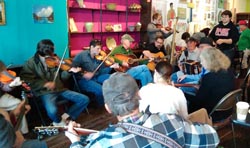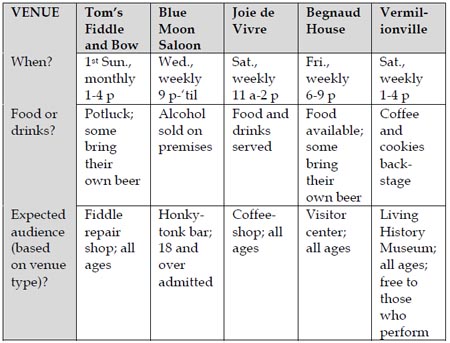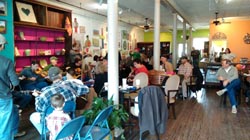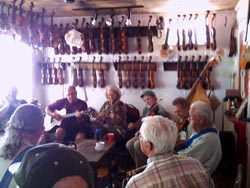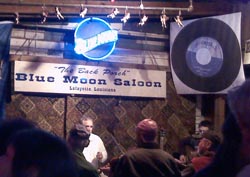Different “Jam” Venues, Contrasting Ways: A Comparison of Cajun Music Jams in and around Lafayette, Louisiana
By Marie-Laure Boudreau
As in a number of other orally transmitted musical traditions, a common way to play Cajun music is for musicians to assemble for a "jam session." Jams can enter in the category of "participatory performance," which Thomas Turino describes as "a special type of artistic performance in which there are no artist-audience distinctions, only participants and potential participants performing different roles, and the primary goal is to involve the maximum number of people in some performance role" (2008, 26). Turino explains that participatory performance stands in opposition to "presentational performance," which "refers to situations where one group of people, the artists, prepare and provide music for another group, the audience, who do not participate in the making of the music or dancing" (26). Similarly, Michelle Kisliuk explains that jams are not primarily designed as a performance and that "jammers play for their own enjoyment" (1988, 153). In addition to being a leisure activity, a jam is an occasion for the music to be played, heard, and transmitted through oral/aural means from more advanced players to apprentices. It is also a way for those who attend to amass a repertoire.
Even though informal meetings still occur, many "jams" that take place today are planned. Coffee shops, bars, or cultural centers organize them weekly or monthly. As one might expect, the jams held in public spaces in Louisiana are not attended solely by participants (musicians), but typically also attract an audience, a fact that can turn the jams into a hybrid between Turino's definitions of "participatory performance" and a "presentational performance" (2008, 26). Not all jam sessions occur or function in the same way. While some are a self-conscious presentation of heritage to an audience, others are more of a social get-together. The degree to which the jam session is a self-conscious presentation of heritage to the audience is an important factor. A "representation of heritage" showcases an idea of something untouched from the past and tends to reinforce a static musical repertoire and set of performance practices. By contrast, a social gathering functioning as "living tradition" seeks to perpetuate elements from the past evolving with the present and into the future, and therefore creates a space for new songs, unusual instruments, and other novel elements.
This essay examines various Cajun music jam session locations ranging from Vermilionville (a Living History Museum & Folklife Park in Lafayette); The Begnaud House (a visitor's center in Scott); Joie de Vivre (a coffee shop in Breaux Bridge); The Blue Moon Saloon (a bar located in the "back porch" of what is also a guesthouse in Lafayette); and Tom's Fiddle and Bow (a violin repairman's shop in Arnaudville). Although none of the places I will mention in this essay can be simply described as either a representation of heritage or a living tradition, the jams observed situate themselves along a continuum. The way a jam is organized, most often illustrated through the parameters of the music played and the interaction of some of the musicians with the public, influences its orientation towards a representation of heritage or a living tradition. The essay relies on descriptions of various jam sessions and interviews with different people familiar with the "jam scene" in order to ascertain the influence of the different elements involved in a public event (venue purpose, organization, type of attendance, level of self-consciousness of presentation of heritage, etc.) that determines the event's placement on the continuum.1
It is significant to note that musicians' motivations to attend a jam vary. Freddie Hanks, a retired musician, comments with humor: "Les jams, c'est plus pour la compagnie que la musique. On a plus de place pour se rencontrer, et on veut pas aller à l'église . . . (laughs)." ["The jams are for company more than for music. We have no more place to meet and we don't want to go to church."] However, jam sessions may perform additional functions. Talking about a jam at the Begnaud House, Joel Breaux, a semi-professional musician, observes that the attendees are sometimes three or four generations apart. He says, "You could see the culture . . . transcending these four generations of people . . . unite two people that would otherwise probably have not [a] . . . thing in common." Jam sessions are also places where tradition and musical skills can be learned, and the organizer`s vision is crucial to musical behavior at a jam. As Jude Meche observes in his account of the Savoy Music Center's jam, jams are not only a "continuity of the culture, it is also one means by which a particular historical vision of the culture is maintained and re-inforced. In many cases, these jams are organized by activists working to maintain or preserve the culture" (2010/2011, 82). Nevertheless, a jam is still a live event; no one can control completely what is going to happen.
Description of the Jam
The jams I observed contain a few common elements. First, each meets regularly and at a public location. Second, each attracts an audience, although its composition varies from location to location. Most jams have regulars who attend, and in some cases, their presence is enough to keep the jam going: this is the reason why some jams don't have appointed leaders. Some locations hire one or two professional musicians to lead the jam, providing a strong musical base and attracting other musicians. When present, the leader, who determines the songs played and enforces the "jam etiquette,"2 is often the accordion player, although other players may have some input on the matter. For example if the accordion player asks another musician to sing, that musician may pick the song. Finally, each presents musicians, ranging from professionals to amateurs, who play an undetermined and unrehearsed musical set that emphasizes a traditional repertoire of songs but also may include improvisation within the music.
At most locations, the musicians participating in the jam are organized in a circle, though they may begin in a semi-circle. In the majority of the jams, the musicians are only engaged with the other "jammers." The jammers, once in the circle, will pay attention mostly to what is going on in the music and not too much to the audience. At the same time, one cannot ignore the audience completely, since the jammers are somewhat conscious that they are being observed. As a result, interactions sometimes happen with the audience, but they are more likely to be brief and not aimed at the audience as a whole, but rather at a specific person or group of persons. However, even those who are not consciously "performing" are doing so in a way, if we consider Erving Goffman's idea that a person in a social context is always "performing" (1973, 17-86). As Goffman's waiter is playing his "role" (1973, 76), so is a musician in a jam.
The separation between audience and jammer drawn by the organizers is an important factor in determine the jam's position on the spectrum. The more distinct the line between the participants and the audience, the closer the jam is on the continuum to the representation of heritage. In a living tradition, it is more likely that the people in the audience will get involved in the music at some point, and that the participants/jammers will become the audience at some point later in the event. Also, the risks that the musicians may take often hints at how much they consider the jam as a performance for an audience or as an opportunity to engage in an active musical discourse—an environment to "test" songs and learn new ones. As Turino points out, in a "participatory performance," the end product is not as important as the "doing" of the activity (2008, 28), so even though the participants prefer that the music sounds good, that is not the ultimate goal. If a song falls apart, it is not the end of the world. The fun is in the "playing." In other words, jams can push the music. They encourage innovation and improvisation, which are not customary in a self-conscious performance (unless by very talented musicians or within specific styles of music accustomed to those characteristics).
From my observation and participation in the different jams, the presence of tourists in itself does not necessarily encourage a jam to become a representation of heritage but the manner in which the jammers considers the jam as a performance for these tourists and for an audience in general does. For instance, the Blue Moon Saloon is a venue with significant tourist traffic, but young local people constitute the most part of the audience on jam nights. The jammers consider that the locals mostly go for the social scene, even though they may enjoy the music, too. Some musicians may go mostly to socialize, as Wilson Savoy, the accordionist of The Pine Leaf Boys, told me he did, and then decide to play a few songs. As Joel Breaux observes, "There's tourists at the Blue Moon, but the musicians that are on the stage feel no responsibility towards the tourists." In fact, at the Blue Moon, the jam is happening on stage, but half of the musicians actually turn their back to the audience. The stage is used to delimit the jam space rather than for its conventional use.
Some characteristics of the jam venue's organization and type of attendance. These venues host the most popular acoustic jams in and around Lafayette, LA, today. I intentionally left out the Savoy Music Center jam near Eunice, since Jude Meche already wrote a specific article on that jam (2010/2011).
At Joie de Vivre, the audience (the coffee shop patrons) is also a mix of locals and tourists enjoying food and non-alcoholic beverages along with the music. The jammers, once in the circle, will pay attention mostly to what is going on in the music and not too much to the audience. Of course, the jam being held in a small town, a musician may wave at somebody he knows or briefly have an exchange between songs with a member of his family or a friend or acquaintance that happens to be there, but there is no presentation of the music or the musicians to a large audience. For instance, there is always a host hired to conduct the jam, but this person is not introduced to the audience—as it is customary at Vermilionville—nor does this person address the crowd per se.
At the Begnaud House, on the nights I participated in the jam, the crowd had some interaction with the jammers, but it was mainly composed of locals and the exchanges were more about telling jokes (which can be seen as another kind of performance) and laid-back interactions rather than a "presentation" of the songs or of "what the jam is about." This jam was also much smaller than the others. As for the jam at Tom's Fiddle and Bow, the gathering is very casual; people bring food, chit-chat in the kitchen, start a spontaneous jam in the back in another musical genre, etc. It is a public event, but because of the configuration of the premises (of smaller dimensions than the other jam spaces) it feels more "semi-private."
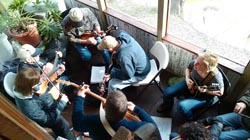
The only place where I witnessed a direct and sustained address to the crowd outside the circle, thus disrupting the intimacy of the circle, is at Vermilionville. When I asked Ray Landry, the organizer, why he was doing so, he replied, "It makes more of an interesting show for the tourists, instead of just sitting there and not understanding the words, liking the music and having no one explain it to him (sic)." He continued, "in my opinion, every jam session should, at least, try to explain where we come from, the hardships we had to go through, even in the music." The reason for such an interaction with the public also comes to light when considering this excerpt from the mission statement of the location: "Vermilionville seeks to enlighten visitors and youth about the history and culture of Acadiana."
The jam at Vermilionville then becomes a performance, a "representation." Because the location seeks to represent a certain historic period of the life in the region (1765-1890), I would call it a representation of heritage, drawing on the definition of "heritage" given by Barbara Kirshenblatt-Gimblett. She defines the concept as "the transvaluation of the obsolete, the mistaken, the outmoded, the dead, and the defunct. Heritage is created through a process of exhibition (as knowledge, as performance, as museum display" (1995, 369). This definition may seem to devalue heritage, but I agree that very often:
tourism and heritage are collaborative industries, heritage converting locations into destinations and tourism making them economically viable as exhibits of themselves. . . . They stage their own rebirth as displays of what they once were, sometimes before the body is cold. (1995, 371)
The cultural tourism industry is certainly an important economic factor in Cajun Country. Barry J. Ancelet points out that,
Until recently, the textbook used to teach Louisiana history had two paragraphs on the Cajuns; one on Evangeline and the other on Justin Wilson, neither of whom is native to the area. Cajuns who go places like Vermilionville and Jean Lafitte learn about their history and culture alongside visitors from the outside, which at its best could be just the kind of empowerment at the grassroots level that folklorists interested in cultural equity seem to hope for. (1992)
It is indeed more accurate to display a Cajun jam session on exhibit than telling fantasies about a fictional character under an oak tree, but it is nevertheless a representation meant for an audience, a fact that the organizer at Vermilionville does not deny. That being said, the jam there, like other jams, still succeeds today at serving a function it had in the past: passing on the tradition from the older generation to the younger one.
The Music
The jams are a place where oral tradition is passed through "skilled conduits," and an opportunity in today's "mediated orality" context3 (orality conveyed through radio, TV, recordings, internet, etc.) to learn songs in direct contact with others. There are contrasting ways to pass on the tradition, depending on the different venues, and they are all good places to learn, each in its own way. A lot of songs are played repeatedly from one jam to another, although never exactly in the same way. Yet, as Anne Dhu McLucas explains, hearing "multiple versions, and generally from one or more skilled performers ('skilled conduits') can paradoxically increase [McLucas' emphasis] the stability of a song" (2010, 46). Indeed, hearing different versions often helps in recognizing the important elements that constitute the core of a song and in differentiating them from the ornaments and other improvised elements a musician inserts in his specific version.
Jams are also very important in the perpetuation of oral transmission. Joel Breaux points out that unlike learning from a recording, where a musician has to actively choose a song and be aware of it beforehand, at the jams, a musician is "kinda forced out of your comfort zone, whereas if you play in a band you play the songs you know . . . I mean I learned so many songs . . . whether if it's the lyrics or certain parts of it . . . if you gotta fake it, you gotta fake it. . . you're kinda learning some portions of it." Kristine Dewey, a jammer who moved to Lafayette from Wisconsin, also says that playing the guitar in jams helps her to understand the songs harmonically and enables her to recognize more songs, especially the ones that "are tricky." The "tricky" songs she talks about are the ones that stand out because they carry more elaborate chord structures.
In addition, the presence of professional musicians attending jams (whether they are leading or they are just attending for fun) is very instructive for others, and, as described by Joel Breaux, is a different musical experience—one that offers an exposure to the subtleties lost in amplified stage performance. The interaction with advanced musicians is not only a passing of expert knowledge, but also a reworking of how this music can be played. Indeed, the professional or advanced musicians often tend to bring to traditional music "re-shaping" and "renewal"—as one scholar has labeled them and has described as processes that involve re-arrangements, variations, new lyrics, interesting combinations of melodies, etc. (Åkesson 2006, 23-24). "Re-shaping" and "renewal" are more likely to happen in jams that are open to this kind of experimentation. Jams where experimentation is welcome are, in my point of view, necessary for the tradition to live. It is also a way to keep advanced musicians interested in the activity, as Turino notes: "To keep everyone engaged, participatory musical and dance roles must have an ever expanding ceiling of challenges, or a range of activities that can provide challenges, while, at the same time, there must be an easy place for young people to begin" (2008, 31). "Re-shaping" and "renewal," while keeping known elements of the tradition, insert challenging ones, which creates a space where different levels of musicianship can coexist.
At Vermilionville, the leader and venue exert greater control over what is being played, how it is being played, who is going to sing, etc. than in other venues. This fact may limit spontaneity, as do the long pauses in between songs, and the frequent commentary directed to the audience. The music philosophy of the organizer Ray Landry reflects this observation:
The mission statement for Vermilionville is to preserve Cajun culture and music as we knew it in the 1850s to 1890. . . .I don't think the music has to be changed. I think it needs to stay the same. . . . I encourage all the musicians to stay traditional at the jam session. And we do that through trying to regulate, actually what is played.
A problematic aspect of this approach is that we have no sound artifact of what the music was like in the late 1800s. When Cajun music started being recorded at the end of the 1920s, musicians had already been exposed, through radio at least, to other types of music. Therefore, how can one know for certain that the sound recordings considered "genuine Cajun music" are not already "acculturated?" In fact, drawing on Harry Oster"s observations in his article from 1958 "Acculturation in Cajun Folk Music," most traditional dance music would enter the category he describes as "hybrid . . . which combine[s] lyrics in Cajun French with elements from one or more outside sources (southern mountain folksongs, commercial popular music of the country-and-western type, and Negro folk music of the blues variety)" (2006, 47). Oster also emphasizes the role played by "the rise of the phonograph, radio, motion pictures, and most recently television" (2006, 47) in the acculturation process. Musicians are influenced by what they hear, consciously or not. Cajun music has always evolved, and this is what happens in any living tradition.
Besides, being an oral tradition, many versions of the songs circulate. Now, in our world of "mediated orality," the influence of the recordings is noticeable due to the fixity they imply. Many versions of the songs still circulate, but some recordings become a reference. As an example, in all the jams when the song "Les Veuves de la Coulée" was played, it was played each time with instrument "breaks" in the middle of the accordion tune, showing an influence from a recording that I believe can be traced back to the Austin Pitre version from 1971 (and adopted in many later versions). In all the older versions of this song available at the Cajun and Creole Music Collection of University of Louisiana at Lafayette, including versions by Happy Fats and his Rayne-bo ramblers, Harry Choates and Vin Bruce and early Balfa Brothers, these "breaks" are not part of the recording. Hearing this musical feature in jam over and over again reinforces it as being an essential trait of the song. However, this feature seems to be overused on some occasions in jams. Sometimes, players do the instrumental break each time the tune is played—regardless if the tune is played by the fiddle, the accordion or sung—turning a surprising arrangement into a repetitive and predictable musical element.
Another example of perceivable fixity of versions is the influence of songbooks, such as Yé Yaille, Chère, Traditional Cajun Dance Music (François 2000) and Cajun Music: A Reflexion of a People (Savoy 1984). The versions published in these songbooks are very popular. This has to do, in part, with the idea of fixed versions ("the true version") brought by the mediated orality world we live in, but also with the often restricted knowledge of the French language among singers. However, when a singer has a greater mastery of the French language, he or she may substitute alternate lyrics heard from a recording, or may be able to improvise lyrics on the spot. In the latter case, apart from the knowledge of the French language, the singer must also have an ability to think fast enough to marry words and rhythm. Traditionally, the singers often improvised lyrics in dancehalls, and even on recordings, as one can observe when various lyrics have been recorded to the same melody. But some recordings, more popular than others, fixed a set of lyrics (or a few sets of lyrics) as the song. Jam sessions often reflect this reality that there is the song; and the songbooks of course helped to establish this idea. However, talented musicians can even overcome this obstacle. For example, Blake Miller explained to me that people think that he knows all the songs simply because he makes up words if no one else is singing. There is also a singer at Joie de Vivre Jam who is famous for turning any song"s lyrics into praise for the City of Breaux Bridge.
On another matter, the Blue Moon jam is probably the most "open" in terms of repertoire, a place where unusual songs can be heard. For instance, one evening I recall Blake Miller playing three Bruce Daigrepont songs in a row. Indeed, it is uncommon to hear recently-composed songs at this jam. It is also open in terms of instrumentation (I have witnessed bagpipes, saxophone, African banjo, and so on) and song structure; some players come up with "crooked"4 songs. There is always a risk in playing those "jam busters" as some call them (because they are harder to follow and demand more musicianship or ear attention), but it is challenging in a good way. Cedric Watson is well-known for playing "crooked" songs and, being a strong player, he can carry the tune well enough so that people paying attention likely will catch onto the structures. There is also no appointed leader, although whoever picks the accordion becomes more or less the leader for that time.
Perhaps the best example of Blue Moon's openness is my experience one evening during a jam. While Blake Miller was playing the accordion that night, a man from Montreal asked to sing "L'Arbre est dans ses feuilles," a traditional song popular-ized by Zachary Richard that is not part of the "classic" Cajun repertoire played at jams. We all played it. The visitor sang and everyone joined in the chorus, very spontaneously, even though many people claimed not to know the song firsthand. Joel Breaux says, recalling this event:
The Blue Moon jam, sometimes it's a total train wreck, but sometimes the music is really good, man! Sometimes the music is amazing! But it's not controlled . . . . If you think of an artifact in a museum is about preservation; that's not about preservation, 'cause there's no controlling element, there's nothing directing where it's headed. . . . it's like allowed to go wherever it wants to go, and if it falls apart, well then it falls apart . . . any given night it can start off really strong and totally fall apart, then at one o'clock in the morning it's like a really strong jam again. It's probably the only jam that I know of where it tends to get better the later it goes! . . . Something alive about that, it's like a living thing.
Wilson Savoy, who attends regularly, points out that the attitude of the crowd, too, seems to be genuinely about having fun more than anything else:
People come now to the Blue Moon on Wednesday nights, like . . . it's like a free show. They come out to dance. Like, there's more people dancing than there are people playing music. And it's unamplified and it's real; it's not like these people who dress up like "Acadiennes," you know, put on their dresses from 1755, then dance around, . . . no that's fake, as opposed to real.
This last comment, exemplifies the Cajun jam in opposition to a type of representation of heritage that portrays re-creation of tradition out of actual context. Heritage production and presentation are often seen by the cultural institutions as means of cultural "preservation." But, as Joel Breaux comments, the term "preservation" does not seem appropriate to designate what the Cajun jams are about:
In my mind, when a culture is being preserved, it's already dead, . . . you can't have a living culture if it's kinda being preserved, . . . in order to be a living culture it has to be lived.
Dewey Balfa, reported by Barry Ancelet, said: "I'm interested in the very life of this culture and how it continues to evolve in its own terms. I don't want to freezedry[sic] it or pin it to a wall like a dead butterfly" (2003, 86). Ancelet explains:
Dewey was not only a musician, but what folklorists have come to call a community scholar, that is, a member of a folk community who has learned to address the issues that are at the heart of the study and practice of folklore, such as cultural equity and the relationship between preservation and innovation within the traditional context. (2003, 86)
Innovation has always happened; it is noticeable when studying recordings. As for the "preservation," it seems to take place naturally. As Joel Breaux told me, "We're playing historic songs mostly because everybody can follow them. People aren't playing them to preserve it, they're playing it, it's because everybody knows it and it's like everybody will be able to follow. . . . " Indeed, an effective way to keep tradition alive appears to be when it's done unconsciously. While a venue like Vermilionville is self-consciously presenting heritage to an audience of outsiders, something that the Begnaud House might also be looking for on a smaller scale, venues like Joie de Vivre, The Blue Moon, and Tom's Fiddle and Bow are more likely to attract audiences for which the heritage aspect is not the main interest, in part due to the raison d'être of the venues. Still, Cajun jams all gravitate to a traditional repertoire, but with a different musical approach in terms of possible innovation inside the music. The degree to which a jam session is conceived as a presentation of heritage to an audience being an important factor in the way tradition is being passed on, we've seen that there are clearly contrasting ways of passing on tradition.
Notes
1. My observations for this essay come from my work as a musician. I attended all of the jams discussed here as a musician; some of them regularly, others just a few times. At the jams, I usually played guitar because it is an instrument that allows observing the dynamics of the jam, but on some occasions, I also played accordion. Most of my observations come from a guitarist's perspective. Playing accordion has a greater influence on the jam, so jamming as a guitarist offers a more participatory point of view, which is better for assessing the influence of jam sessions on musicians. I also conducted several interviews with other musicians at the jams. Some of the interviewees I know very well and others I only know from playing at the jams sessions with them. Each one of the interviewees has a very different background. The interviews were semi-directive. They were not limited to a series of questions; instead, they consisted of a conversation around a given subject.
2. For an elaborated discussion on that matter, see Meche, 2010/2011 and Kisliuk, 1988.
3. Translation by author of term used by Paul Zumthor (1983, 28).
4. A common way to name irregularly structured songs among musicians.
Sources
Åkesson, Ingrid. 2006. "Re-creation, Re-shaping, and Renewal Among Contemporary Swedish Folk Singers, Attitudes Toward Tradition in Vocal Folk Music Revitalization." STM-Online 9. http://musikforskning.se/stmonline/vol _9/akesson/index.php?menu=3.
Ancelet, Barry J. 1992. "Cultural Tourism in Cajun Country: Shotgun Wedding or Marriage in Heaven?" Folklife in Louisiana. http://www.louisianafolklife.org/LT/Articles _Essays/sFCulturalTourism.html.
___. 2003. "The Theory and Practise of Activist Folklore: From Fieldwork to Programming." Working the Field: Accounts from French Louisiana. Ed. Jacques M. Henry and Sara LeMénestrel. Westport, CT: Praeger. 81-100.
Balfa Brothers. 1976. Les veuves de la coulée. J'ai vu le loup, le renard et la belette. Rounder. LP.
Breaux, Joel. 2013. Interview by author. 14 November. Bruce, Vin. 1970. Veuve de la coulee. Vin Bruce's Cajun country. Swallow. LP.
Choates, Harry.1999. Veuve de la coulee. Cajun fiddle king: featuring Jolé Blon, the Cajun anthem. AIM International. CD.
Dewey, Kristine. 2013. Interview by author. 22 November.
François, Raymond E. 2000. Yé Yaille, Chère, Traditional Cajun Dance Music. Ville Platte, LA : Swallow.
Goffman, Erving. 1973. The Presentation of Self in Everyday Life. Woddstock, NY: The Overlook Press.
Hanks, Freddie. 2013. Interview by author. 8 November.
Happy Fats and his Rayne-Bo Ramblers. 1990. La veuve de la coulée. Le Gran Mamou, a Cajun music anthology [sound recording]: 1928-1941: the historic Victor-Bluebird sessions [vol. 1]. Country Music Foundation Records. CD.
Kirshenblatt-Gimblett, Barbara. 1995. "Theorizing Heritage." Ethnomusicology 39, no. 3: 367-80.
Kisliuk, Michelle. 1988. "A Special Kind of Courtesy, Action at a Bluegrass Festival Jam Session." TDR 32, no. 3 (Autumn): 141-155.
Landry, Ray. 2014. Interview by author. 15 February.
McLucas, Anne Dhu. 2010. The Musical Ear: Oral Traditions in the USA. Burlington, VT: Ashgate Publishing.
Meche, Jude. 2010/2011. "Re-playing the Past: Cultural Continuity and the Cajun Jam Session." Culture & Tradition. 31/32: 81-102.
Oster, Harry. 2006. "Acculturation in Cajun Folk Music." Accordions, Fiddles, Two-step & Swing: A Cajun Music Reader. Ed. Ryan A. Brasseaux and Kevin S. Fontenot. Lafayette, LA: Center for Louisiana Studies. 47-54.
Pitre, Austin and his Evangeline Playboys. 1997. Widow of the Gully. Opelousas Waltz. Arhoolie. CD.
Savoy, Ann Allen. 1984. Cajun Music, A Reflection of a People, Vol.1. Eunice, LA: Bluebird.
Savoy, Wilson. 2013. Interview by author. 15 November.
Turino, Thomas. 2008. Music as Social Life. Chicago: University of Chicago Press.
Vermilionville Historic Foundation. Accessed March 15, 2014, http://www.vermilionville.org/vermilionville/founda-tion.htm.
Zumthor, Paul. 1983. Introduction à la poésie orale. Paris: Éditions du Seuil.


